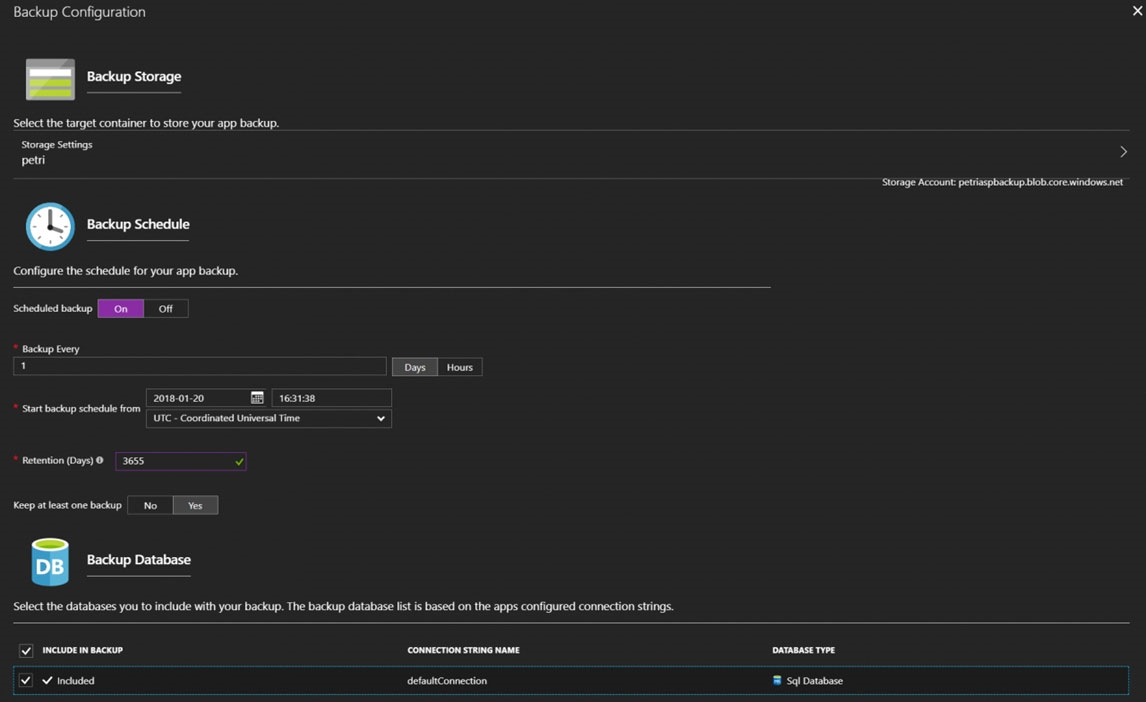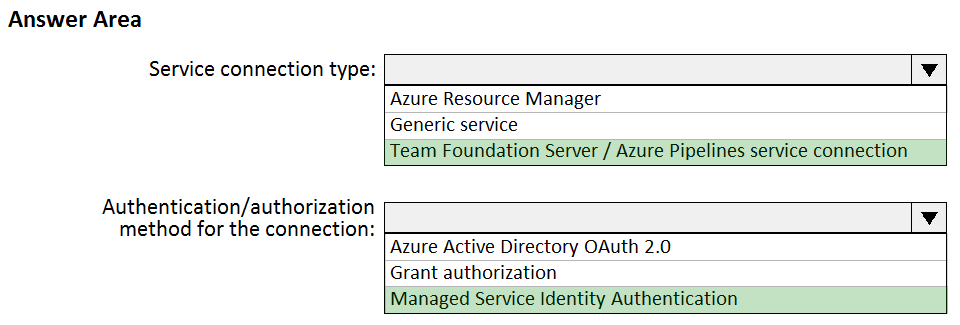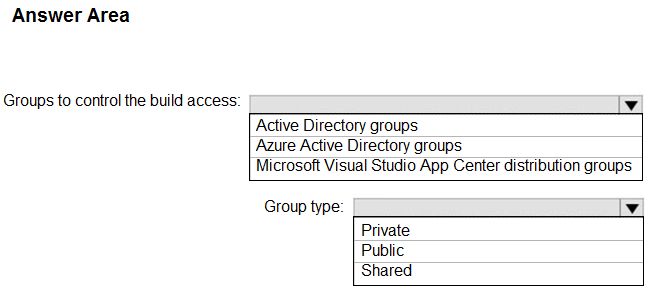SIMULATION -
Your company plans to implement a new compliance strategy that will require all Azure web apps to be backed up every five hours.
You need to back up an Azure web app named az400-123456789-main every five hours to an Azure Storage account in your resource group.
To complete this task, sign in to the Microsoft Azure portal.
Answer:
See explanation below.
With the storage account ready, you can configure backs up in the web app or App Service.
1. Open the App Service az400-123456789-main, which you want to protect, in the Azure Portal and browse to Settings > Backups. Click Configure and a
Backup Configuration blade should appear.
2. Select the storage account.
3. Click + to create a private container. You could name this container after the web app or App Service.
4. Select the container.
5. If you want to schedule backups, then set Scheduled Backup to On and configure a schedule: every five hours
6. Select your retention. Note that 0 means never delete backups.
7. Decide if at least one backup should always be retained.
8. Choose if any connected databases should be included in the web app backup.
9. Click Save to finalize the backup configuration.
Reference:
https://petri.com/backing-azure-app-service
SIMULATION -
You need to configure a virtual machine named VM1 to securely access stored secrets in an Azure Key Vault named az400-123456789-kv.
To complete this task, sign in to the Microsoft Azure portal.
Answer:
See explanation below.
You can use a system-assigned managed identity for a Windows virtual machine (VM) to access Azure Key Vault.
1. Sign in to Azure portal
2. Locate virtual machine VM1.
3. Select Identity
4. Enable the system-assigned identity for VM1 by setting the Status to On.
Note: Enabling a system-assigned managed identity is a one-click experience. You can either enable it during the creation of a VM or in the properties of an existing VM.
Reference:
https://docs.microsoft.com/en-us/azure/active-directory/managed-identities-azure-resources/tutorial-windows-vm-access-nonaad
DRAG DROP -
Your company has an Azure subscription named Subscription1. Subscription1 is associated to an Azure Active Directory tenant named contoso.com.
You need to provision an Azure Kubernetes Services (AKS) cluster in Subscription1 and set the permissions for the cluster by using RBAC roles that reference the identities in contoso.com.
Which three objects should you create in sequence? To answer, move the appropriate objects from the list of objects to the answer area and arrange them in the correct order.
Select and Place:
Answer:

Step 1: Create an AKS cluster -
Step 2: a system-assigned managed identity
To create an RBAC binding, you first need to get the Azure AD Object ID.
1. Sign in to the Azure portal.
2. In the search field at the top of the page, enter Azure Active Directory.
3. Click Enter.
4. In the Manage menu, select Users.
5. In the name field, search for your account.
6. In the Name column, select the link to your account.
7. In the Identity section, copy the Object ID.
Step 3: a RBAC binding -
Reference:
https://docs.microsoft.com/en-us/azure/developer/ansible/aks-configure-rbac
HOTSPOT -
You manage build and release pipelines by using Azure DevOps. Your entire managed environment resides in Azure.
You need to configure a service endpoint for accessing Azure Key Vault secrets. The solution must meet the following requirements:
✑ Ensure that the secrets are retrieved by Azure DevOps.
✑ Avoid persisting credentials and tokens in Azure DevOps.
How should you configure the service endpoint? To answer, select the appropriate options in the answer area.
NOTE: Each correct selection is worth one point.
Hot Area:
Answer:

Box 1: Azure Pipelines service connection
Box 2: Managed Service Identity Authentication
The managed identities for Azure resources feature in Azure Active Directory (Azure AD) provides Azure services with an automatically managed identity in Azure
AD. You can use the identity to authenticate to any service that supports Azure AD authentication, including Key Vault, without any credentials in your code.
Reference:
https://docs.microsoft.com/en-us/azure/devops/pipelines/tasks/deploy/azure-key-vault https://docs.microsoft.com/en-us/azure/active-directory/managed-identities-azure-resources/overview
You are deploying a server application that will run on a Server Core installation of Windows Server 2019.
You create an Azure key vault and a secret.
You need to use the key vault to secure API secrets for third-party integrations.
Which three actions should you perform? Each correct answer presents part of the solution.
NOTE: Each correct selection is worth one point.
Answer:
BCE
BE: An app deployed to Azure can take advantage of Managed identities for Azure resources, which allows the app to authenticate with Azure Key Vault using
Azure AD authentication without credentials (Application ID and Password/Client Secret) stored in the app.
C:
1. Select Add Access Policy.
2. Open Secret permissions and provide the app with Get and List permissions.
3. Select Select principal and select the registered app by name. Select the Select button.
4. Select OK.
5. Select Save.
6. Deploy the app.
Reference:
https://docs.microsoft.com/en-us/aspnet/core/security/key-vault-configuration
HOTSPOT -
Your company is creating a suite of three mobile applications.
You need to control access to the application builds. The solution must be managed at the organization level.
What should you use? To answer, select the appropriate options in the answer area.
NOTE: Each correct selection is worth one point.
Hot Area:
Answer:

Box 1: Microsoft Visual Studio App Center distribution Groups
Distribution Groups are used to control access to releases. A Distribution Group represents a set of users that can be managed jointly and can have common access to releases. Example of Distribution Groups can be teams of users, like the QA Team or External Beta Testers or can represent stages or rings of releases, such as Staging.
Box 2: Shared -
Shared distribution groups are private or public distribution groups that are shared across multiple apps in a single organization. Shared distribution groups eliminate the need to replicate distribution groups across multiple apps.
Note: With the Deploy with App Center Task in Visual Studio Team Services, you can deploy your apps from Azure DevOps (formerly known as VSTS) to App
Center. By deploying to App Center, you will be able to distribute your builds to your users.
Reference:
https://docs.microsoft.com/en-us/appcenter/distribution/groups
You have an Azure DevOps organization named Contoso that contains a project named Project1.
You provision an Azure key vault named Keyvault1.
You need to reference Keyvault1 secrets in a build pipeline of Project1.
What should you do first?
Answer:
D
Before this will work, the build needs permission to access the Azure Key Vault. This can be added in the Azure Portal.
Open the Access Policies in the Key Vault and add a new one. Choose the principle used in the DevOps build.
Reference:
https://docs.microsoft.com/en-us/azure/devops/pipelines/release/azure-key-vault
Your company uses Azure DevOps.
Only users who have accounts in Azure Active Directory can access the Azure DevOps environment.
You need to ensure that only devices that are connected to the on-premises network can access the Azure DevOps environment.
What should you do?
Answer:
D
Conditional Access is a capability of Azure Active Directory. With Conditional Access, you can implement automated access control decisions for accessing your cloud apps that are based on conditions.
Conditional Access policies are enforced after the first-factor authentication has been completed.
Reference:
https://docs.microsoft.com/en-us/azure/active-directory/conditional-access/overview
You have the following Azure policy.
You assign the policy to the Tenant root group.
What is the effect of the policy?
Answer:
B
Denies non HTTPS traffic.
You have an Azure DevOps organization named Contoso, an Azure DevOps project named Project1, an Azure subscription named Sub1, and an Azure key vault named vault1.
You need to ensure that you can reference the values of the secrets stored in vault1 in all the pipelines of Project1. The solution must prevent the values from being stored in the pipelines.
What should you do?
Answer:
A
Use a variable group to store values that you want to control and make available across multiple pipelines.
Reference:
https://docs.microsoft.com/en-us/azure/devops/pipelines/library/variable-groups